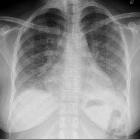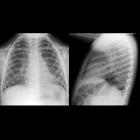Viral respiratory tract infection

























Viral respiratory tract infection is a broad term given to pulmonary infection caused by viruses.
Pathology
They can be caused by any of a large number of viral agents, including but not limited to:
RNA viruses
- orthomyxoviridae
- influenza pneumonia
- H1N1 pneumonia (swine influenza)
- H5N1 pneumonia (avian influenza)
- influenza pneumonia
- paramyxoviridae
- parainfluenza pneumonia (HPIV)
- pneumoviridae
- respiratory syncytial virus (RSV)
- RSV pneumonia
- RSV bronchiolitis
- respiratory syncytial virus (RSV)
- human metapneumovirus (HMTV)
- HMTV pneumonitis
- measles: respiratory tract infection from measles
- mumps: respiratory tract infection from mumps
- coxsackievirus: coxsackievirus respiratory tract infection
- echovirus: echovirus respiratory tract infection
- enterovirus: enterovirus respiratory tract infection
- bunyaviridae
- hantavirus
- coronaviridae - human coronaviruses (hCoV)
- picornaviridae
- rhinovirus
DNA viruses
- adenovirus: adenovirus lung infection
- herpesviridae
- herpes simplex virus (HSV)
- herpes simplex virus type 1 (HSV1) pneumonia
- cytomegalovirus (α herpesvirinae): cytomegalovirus pneumonia
- varicella-zoster virus (VZV) (β herpesvirinae): varicella pneumonia
- herpes simplex virus (HSV)
- Epstein-Barr virus (EBV): EBV pneumonia
- human papillomavirus (HPV): HPV pneumonia
- parvoviridae
Radiographic features
Plain radiograph / CT
The most common findings include bilateral perihilar peribronchial thickening and interstitial infiltrates which, particularly in children, due to their small-caliber airways, can result in areas of atelectasis or air trapping. Sometimes airspace consolidation or hemorrhage may also develop. Pleural effusion, hilar lymphadenopathy and pneumothorax are uncommon findings.
Imaging findings alone are not specific enough for the definitive diagnosis of viral pneumonia and radiographic patterns can be variable, depending on the specific viral strain, as well as host factors.
Siehe auch:
und weiter:

 Assoziationen und Differentialdiagnosen zu Viruspneumonie:
Assoziationen und Differentialdiagnosen zu Viruspneumonie:


